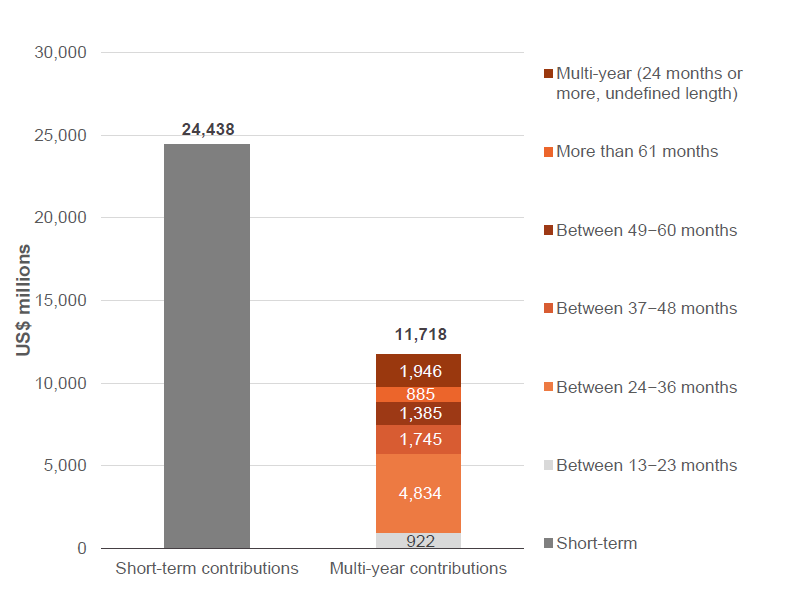Multi-year humanitarian funding: Global baselines and trends: Chapter 3
Duration of funding from donors
DownloadsFigure 2: More than 90% of donors’ multi-year humanitarian contributions between 2016 and 2018 were for 24 months or more

Donors' multi-year humanitarian contributions between 2016 and 2018 totalled 11,718 million US dollars. Of this, more than 90 percent was for 24 months or more. Short-term contributions for the same period totalled 24,438 million US dollars.
Source: Development Initiatives, based on data provided bilaterally and from the International Aid Transparency Initiative (IATI). Data was collected between April and August 2019.
Notes: The dataset shown in the chart covers 11 institutional donors that are Grand Bargain signatories and reported to our survey. Multi-year funding also refers to funding agreements ranging between 12 and 24 months when defined as multi-year by the donor. DFID data was collected from IATI and includes some technical operation costs. Data is in constant 2017 prices.
There is no commonly used definition of multi-year funding nor agreed duration for funding to be considered “multi-year”. Some donors use the OECD and Good Humanitarian Donorship guidance [1] defining multi-year funding as that which spans a minimum of two years. However, these definitions are not universally endorsed or used in reporting, and two other main interpretations of multi-year funding emerge: funding that covers at least 18 months, and funding with a duration longer than 12 months.
- Between 2016 and 2018, almost a third (32%) of reported humanitarian contributions were multi-year, while over two thirds (68%) were short-term, based on donors’ own definitions.
- Regardless of the definition applied by donors, 92% of all reported contributions of multi-year humanitarian funding were for a period of 24 months or more.
- Where donors use definitions of “multi-year” for funding with a duration of “more than 12 months” or “more than 18 months”, only 14% (US$922 million) of their total multi-year contributions over the period 2016 to 2018 were for a period of less than 24 months.
- Donors using the two-year (24 month) definition of “multi-year” account for 76% of total short-term funding. This reported short-term funding may capture arrangements with a duration of between 13 and 23 months, however, granular data is not available to gauge the volume of funding of this duration.
- Close to half (49%) of the reported multi-year contributions had a duration of up to 36 months. Of these, 84% spanned between two and three years. However, there remained a significant share of contributions classified as multi-year that were provided for a period of more than two years (17%), but for which the exact duration of the funding was not provided.
Downloads
Notes
-
1
OECD, Multi-Year Humanitarian Funding (2017), page 1. Good Humanitarian Donorship define multi-year funding similarly, but note that multi-year planning and funding should be arrangements of “two or more years with agreed budgets that allow for incremental funding”, based on multi-year planning frameworks and the development of multi-year programming strategies in collaboration with partners. https://www.ghdinitiative.org/ghd/gns/best-practices.html (accessed 4 February 2020).Return to source text